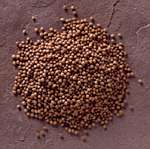
Mustard Seed
General Description
Mustard Seed comes from two large shrubs, Brassica juncea (brown mustard) and Brassica hirta (white mustard), native to Asia. Both plants produce bright yellow flowers that contain small round seeds; brown mustard is more pungent than white.
Geographical Sources
Canada and the United States.
Traditional Ethnic Uses
Mustard Seed's hot and spicy flavor enhances meats, fish, fowl, sauces, and salad dressings. Whole Mustard Seed may be used in pickling or in boiling vegetables such as cabbage or sauerkraut. Brown Mustard Seeds are an important flavoring in Indian dishes.
Taste and Aroma Description
Powdered Mustard has no aroma when dry, but a hot flavor is released when it is mixed with water.
History/Region of Origin
Mustard was used in ancient Greece and Rome as a medicine and a flavoring. By 800 AD, the French were using Mustard as an enhancement for drab meals and salted meats. It was one of the spices taken on Spanish explorations during the 1400s. Mustard powder was invented by Mrs. Clements of Durham, England, who made a fortune selling the dry, pale-yellow mustard flour.
Storage Tips
Store in cool, dark, dry places.
A Few Ideas to Get You Started
Before using, mix Mustard Powder with water to form a paste. It takes about 10 minutes for the mustard flavor to develop. Use in foods needing flavor highlights. Unlike other pungent spices, Mustard's flavor does not build or persist. Mustard helps emulsify liquids - use in salad dressing recipes to help blend oil and vinegar and add a spicy zip.
